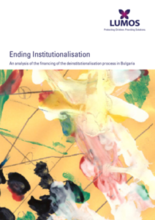According to this report from Lumos, in 2010 there were more than 6,700 children living in institutions in Bulgaria. This rate was higher than the international average. In 2009, 3,000 children in Bulgaria were admitted into institutions. Lumos reports that conditions were particularly poor in disability institutions and mortality rates were unusually high.
In 2010 Bulgaria launched many reforms in order to lower the number of children entering and living in institutions. The reforms involved strengthening social services, foster care development programs, and transferring disabled children out of institutions and into community based services. The report notes that during the time period 2010 to 2014, Bulgaria cut the number of children in institutions by 59%. Mortality rates have dropped but there is a concern about the mortality rates in baby institutions.
This report contains a financial analysis of the reforms to date. The cost to keep a child in an institution has increased 100%. This is because the cost to run the institution has remained fairly stable. The report includes comparative costs for different types of support.
The report also contains case studies that highlight children with disabilities.

